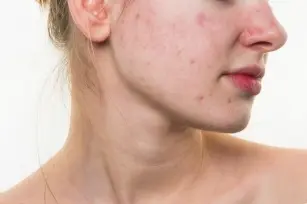
It is most common in people with light skin or with vascular skin. Its most characteristic symptoms are pustules and spider veins. The causes of rosacea are not entirely clear – it is only known that they are related to vasomotor disorders and hormonal changes. Genes are often to blame. How to recognize the symptoms of this type of acne and can it be eliminated?
According to statistics, this disease is most common among people living in Northern and Western Europe and North America. Specialists consider the genetic origin of this ailment, at the same time, many potential causes of rosacea have been distinguished:
- digestive disorders,
- Intolerance to certain foods
- bacterial infections,
- UV radiation,
- Seborrhea or abnormal composition of sebum,
- Hormonal disorders,
- hair follicle infection,
- digestive system diseases,
- Too long use of creams and ointments containing steroids.
Symptoms of this condition usually appear between the ages of 20 and 30. Currently, it affects 10% of the population aged 30-55. People with fair hair, eyes and complexion are most often affected by it. Initially, it covers the middle part of the face, where erythema and dilated blood vessels appear, then also pustules and papules. The dominant symptom of acne is paroxysmal reddening of the face. Exacerbation of these changes occurs mainly as a result of stress and exposure to the sun, and due to:
- Consuming heavy meals and alcohol,
- Appearance of cold sores,
- Large doses of vitamins B6 and B12,
- Using swimming pools with chlorinated water or saunas,
- Thyroid disease, or menstrual disorders (problems with hormones),
- Taking cholesterol-lowering medications.
Rosacea can occur in four forms:
- Papulopustular form: persistent erythema in the center of the face with occasional pustules and papules.
- Erythematous telangiectasia: persistent or transient erythema accompanied by a burning sensation, facial edema and telangiectasia.
- Ophthalmic form: difficult to recognize, usually manifested by chronic inflammation of the edges of the conjunctiva, eyelids and corneas, sometimes there is hyperaemia of the eyes, stinging, photophobia, the feeling of a foreign body in the eye, as well as recurrent barley and chalazion.
- Form with dominance of hypertrophic changes: acne manifests itself in the form of nodular changes, thickened skin with an irregular surface, most often covering the nose, forehead, ears, cheeks or chin.
If you experience any of these symptoms, you need to see a dermatologist. He will choose the right method of treatment, based on local treatment (usually the use of metronidazole in the form of a gel or cream), general treatment (i.e. factors that cause acne, e.g. hormonal disorders, stomach problems), or by choosing the right cosmetics.
Unfortunately, rosacea cannot be completely cured – you can only alleviate the symptoms of the disease. Although treatment with oral medications and topical preparations should be used to minimize its effects and prevent the appearance of new lesions, so far there is no effective drug that would allow you to get rid of it completely.









